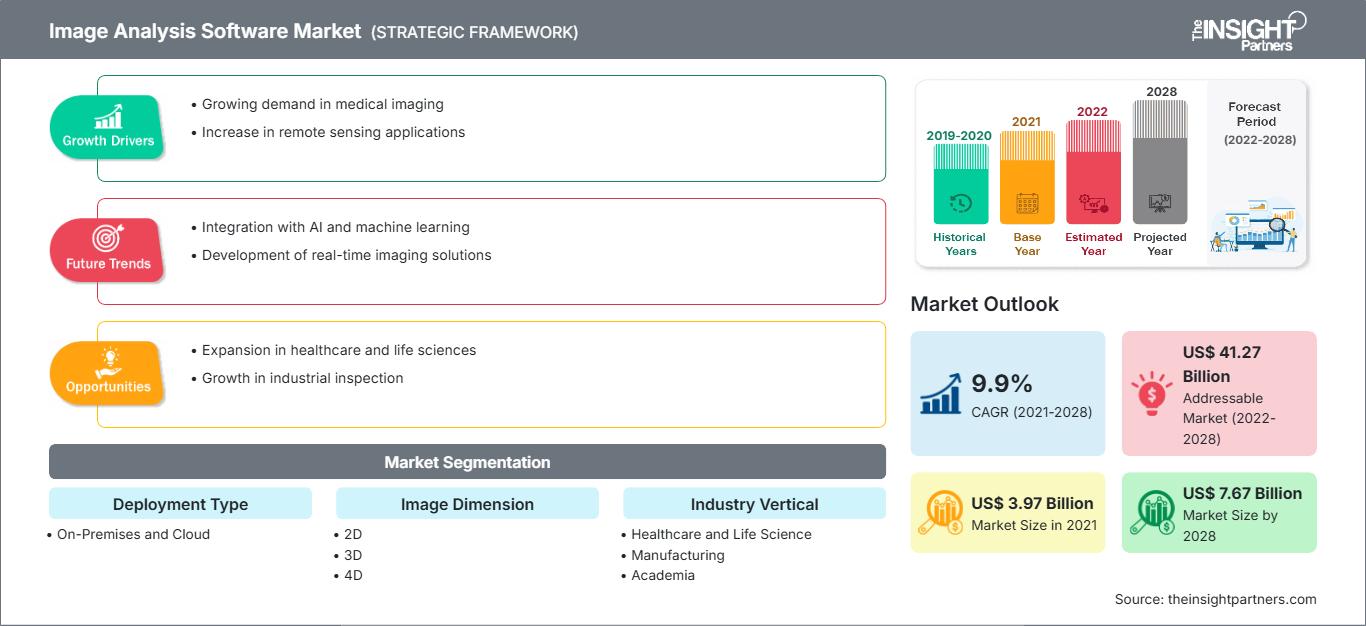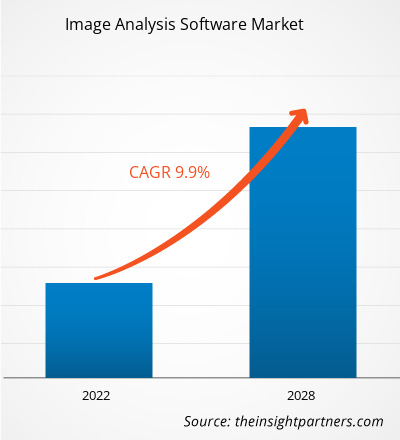[研究报告]图像分析软件市场预计将从 2021 年的 39.7093 亿美元增长到 2028 年的 76.7216 亿美元;预计 2021 年至 2028 年的复合年增长率为 9.9%。
图像分析软件市场,通常称为图像分析市场,利用数字图像处理技术,帮助从图片(主要是数字图像)中提取有价值的数据。图像分析任务范围很广,从简单的扫描条形码标签到复杂的人脸识别。计算机需要处理海量数据、完成需要复杂计算的任务以及提取定量数据。当计算机或电子设备分析图片以提取可用信息时,这被称为数字图像分析或计算机图像分析。它将模式识别、数字几何和信号处理融入计算机或机器视觉以及医学成像领域。由人工智能 (AI) 和机器学习 (ML) 驱动的图像分析软件应用程序重新定义了汽车行业。它目前正应用于汽车制造业的设计、供应链、生产和后期制作。此外,人工智能和机器学习正应用于“驾驶辅助”和“驾驶员风险评估”系统,彻底改变了交通运输行业。人工智能也在改变各种售后服务,例如预测性维护和保险。在汽车行业,机器学习促进了新型智能产品的开发和工作方法的改进。
形状识别、边缘识别、降噪、物体计数以及生成用于纹理分析或图像质量的统计数据都是图像分析任务的示例。它是对二维 (2D) 或三维 (3D) 数字图像进行定量或定性表征,其中计算机视觉分析二维图像,而医学成像分析三维图像。图像分析软件广泛应用于显微镜图像分析和科学图像研究。图像分析软件市场的增长主要得益于医疗保健和生命科学行业对该软件的广泛应用。
自定义此报告以满足您的要求
您将免费获得任何报告的定制,包括本报告的部分内容,或国家级分析、Excel 数据包,以及为初创企业和大学提供超值优惠和折扣
图像分析软件市场: 战略洞察

-
获取本报告的主要市场趋势。这个免费样本将包括数据分析,从市场趋势到估计和预测。
COVID-19 疫情对图像分析软件市场的影响
COVID-19 疫情使图像分析软件市场受益。由于 COVID-19 疫情和远程工作环境的发展,企业面临新的挑战。COVID-19 疫情凸显了各行各业公司采用数字技术并利用图像分析软件市场解决方案和服务的潜力来优化运营和成本的必要性,这将进一步提高 IT 工具的投资回报率。此外,2020 年的疫情给全球图像分析软件市场运营带来了一系列挑战。由于 COVID-19 病例的增加,发达经济体的医疗基础设施崩溃。因此,公共医疗紧急情况需要政府和市场参与者进行干预,并通过合作开展研发计划来协助恢复图像分析软件市场的运营和收入,以弥补预测期内的损失。此外,投资的增加预示着未来几年图像分析软件市场将迎来良好发展。
图像分析软件市场洞察:对支持图像分析的安全应用和产品的需求不断增长
企业已经开始看到从非结构化数据中获取资源的潜力。他们可以利用照片或视频在零售、娱乐、保险理赔和其他行业打造独特且引人入胜的消费者体验。图像分析正被用于支持越来越多的企业用例。深度学习和图像分析的这些实际应用源于机器学习算法的进步、数据集的可用性以及拥有支持实时处理的强大技术平台。美国许多机场正在升级其设备,以支持指纹或虹膜扫描等生物识别技术作为替代的安全检查技术。公司预计,通过部署图像分析技术,将乘客从到达、安检到登机口的交通方式显著提升机场容量。
图像分析软件市场 - 部署类型细分洞察
根据部署方式,图像分析软件市场分为本地部署和云端部署。本地部署软件安装并运行在用户或组织本地的计算机上,而不是在服务器集群或云端等远程设施上。由于本地部署软件提供了更好的灵活性、稳定性和安全性,许多市场参与者现在都在销售本地部署软件。例如,Imagga 的视觉 AI 解决方案可在公司私有的本地服务器上全面部署。数据敏感型组织可以使用 Imagga 屡获殊荣的视觉 AI 技术执行自动标记、自动分类、颜色提取、自定义训练和面部识别,同时完全遵守隐私法律法规。
图像分析软件市场 - 图像维度细分洞察
根据图像维度,图像分析软件市场细分为 2D、3D 和 4D。2D 图像是使用 x 轴和 y 轴创建的。传统上,2D 图像一直被用作动画和视频的来源。这是一项历史悠久的较老技术,但它仍然是经典之作。这些图像简单、视觉上吸引人且易于使用,不会让客户感到不知所措或感到不安。2D 图像在动画和视频游戏中很常见,因为它们在屏幕上提供了逼真而平坦的运动视角。因此,业内一些企业现在都在提供用于分析 2D 照片的软件。例如,Media Cybernetics, Inc. 的 Image-Pro Plus 2D 图像分析软件可以轻松完成照片采集、计数、测量和分类,并实现自动化操作。该软件包包含显微镜控制、图像捕捉、测量、计数/尺寸计算以及宏开发功能。
图像分析软件市场 - 行业垂直细分洞察
根据行业垂直细分,图像分析软件市场可细分为医疗保健和生命科学、制造业、学术界、矿产、金属和石油等。在医疗行业,图像分析软件在神经病学、心脏病学、骨科、牙科和肿瘤学等各个领域都发挥着重要作用。该软件可以读取 X 射线、核磁共振成像 (MRI)、CT 扫描、PET 扫描和超声波扫描生成的图像。因此,可以自动化和加速流程,避免手动操作并节省时间。该软件可以学习识别这些照片中的特定特征,从而使诊断过程快速准确。医学图像处理软件功能强大。基于人工智能的解决方案可以检测异常情况和潜在的危险异常,并显示患者是癌症还是良性肿瘤。除了常规的二维图像(显示随时间变化的图像)外,该软件还可以读取 3D 和所谓的 4D 照片。
图像分析软件市场
图像分析软件市场参与者专注于新产品创新和开发,通过整合先进技术和功能来参与竞争。2021 年 10 月,Clemex Vision 增加了针对马氏体、铁素体和奥氏体晶粒的独特指令以及机器学习功能。这些新的自动化方法已被添加到现有软件的工具箱中,以提供快速准确的视觉识别复杂微观结构的技术。
根据部署类型,图像分析软件市场分为本地部署和云端部署。根据图像维度,图像分析软件市场细分为二维、三维和四维。按行业细分,图像分析软件市场分为医疗保健和生命科学、制造业、学术界、矿产、金属和石油等行业。按地区细分,全球图像分析软件市场分为北美、欧洲、亚太地区、中东和非洲以及南美。
图像分析软件市场区域洞察
The Insight Partners 的分析师已详尽阐述了预测期内影响图像分析软件市场的区域趋势和因素。本节还讨论了北美、欧洲、亚太地区、中东和非洲以及南美和中美洲的图像分析软件市场细分和地域分布。
图像分析软件市场报告范围
| 报告属性 | 细节 |
|---|---|
| 市场规模 2021 | US$ 3.97 Billion |
| 市场规模 2028 | US$ 7.67 Billion |
| 全球复合年增长率 (2021 - 2028) | 9.9% |
| 历史数据 | 2019-2020 |
| 预测期 | 2022-2028 |
| 涵盖的领域 |
By 部署类型
|
| 覆盖地区和国家 |
北美
|
| 市场领导者和主要公司简介 |
|
图像分析软件市场参与者密度:了解其对业务动态的影响
图像分析软件市场正在快速增长,这得益于终端用户需求的不断增长,而这些需求的驱动因素包括消费者偏好的不断变化、技术进步以及对产品优势的认知度不断提高。随着需求的增长,企业正在扩展其产品线,不断创新以满足消费者需求,并抓住新兴趋势,从而进一步推动市场增长。

- 获取 图像分析软件市场 主要参与者概述
图像分析软件市场 -公司简介
- ADCIS SA
- Bio-Rad Laboratories, Inc.
- Oxford Instruments
- Clemex Technologies, Inc.
- Media Cybernetics, Inc.
- MIPAR Software LLC
- 奥林巴斯公司
- Pax-it
- PerkinElmer, Inc.
- TissueGnostics GmbH
- 徕卡显微系统有限公司
- MVTec Software GmbH
- Carl Zeiss AG
- Scale AI, Inc.
- Labelbox, Inc
- V7 Ltd
- 历史分析(2 年)、基准年、预测(7 年)及复合年增长率
- PEST和SWOT分析
- 市场规模、价值/数量 - 全球、区域、国家
- 行业和竞争格局
- Excel 数据集
近期报告
相关报告
客户评价
购买理由
- 明智的决策
- 了解市场动态
- 竞争分析
- 客户洞察
- 市场预测
- 风险规避
- 战略规划
- 投资论证
- 识别新兴市场
- 优化营销策略
- 提升运营效率
- 顺应监管趋势






















 获取免费样品 - 图像分析软件市场
获取免费样品 - 图像分析软件市场